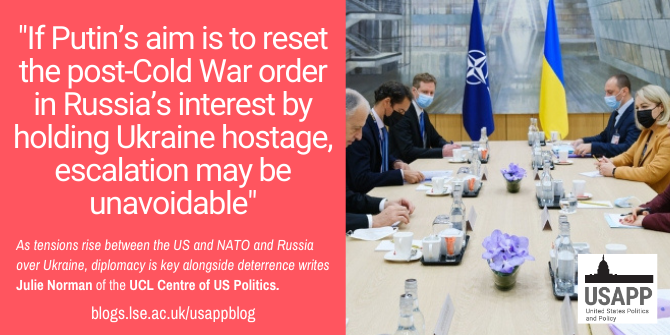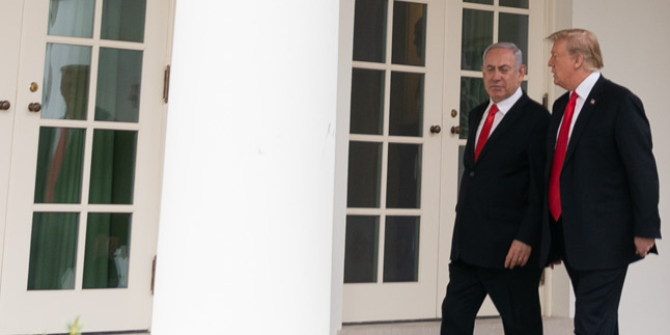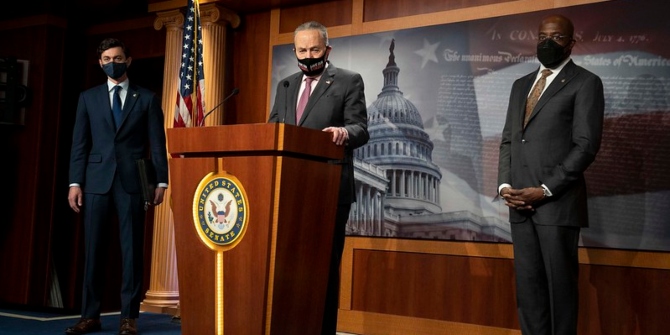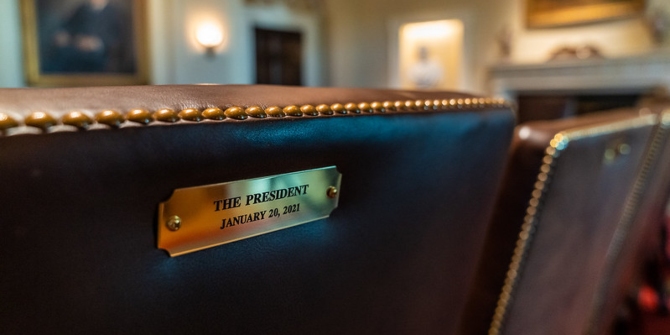 With over 100,000 Russian troops amassed on the Ukrainian border, tensions between Russia, the US, and NATO are at their highest point in decades. In this explainer, Julie Norman discusses the current dynamics of the conflict, and outlines the diplomatic and deterrence strategies that the US and NATO allies are employing to avert an invasion.
With over 100,000 Russian troops amassed on the Ukrainian border, tensions between Russia, the US, and NATO are at their highest point in decades. In this explainer, Julie Norman discusses the current dynamics of the conflict, and outlines the diplomatic and deterrence strategies that the US and NATO allies are employing to avert an invasion.
What does Russia want?
In December 2021, Russia issued a list of demands which would restrict the activities of NATO in eastern Europe. Most significantly, Russia is seeking a legally binding agreement to prevent the further eastward expansion of NATO, including the admittance of Ukraine, as well as a withdrawal of NATO troops and military equipment from eastern European states, which Russia views as a threat to its security. US and NATO allies have rejected those demands outright, but have been open to negotiating on other points regarding military exercises and missile placement in the region.
What actions could Russia take?
Despite the large-scale troop mobilization, there are many actions Russia could take short of a full-scale ground invasion. Militarily, these options include airstrikes or targeted incursions to seize strategic areas. Equally likely, and perhaps in tandem, is the use of nonmilitary tactics to destabilize Ukraine’s government, via disinformation campaigns, cyberattacks, deployment of saboteurs, or, as British intelligence reported last weekend, attempts to install a pro-Kremlin government in Ukraine.
Are diplomatic efforts working?
The US and NATO have been engaged in multiple rounds of negotiations with Russia since December. On Wednesday, the US issued a formal written response to Russia’s demands, as a follow-up to US Secretary of State Antony Blinken’s meeting with Russian Foreign minister Sergey Lavrov in Geneva last Friday. While the response has not been made public, Blinken confirmed that the US rejected the demand to prevent Ukraine from joining NATO, affirming commitment to the sovereignty of Ukraine and the right of states to determine their own security alliances.
NATO also issued a formal coordinated response to Russia, and European-led diplomacy was in full force this week. On Wednesday, officials from France, Germany, Russia, and Ukraine met for eight hours in Paris (in a format established as part of the 2015 Minsk agreements), and French President Emmanuel Macron is scheduled to speak with Russian President Vladimir Putin by phone on Friday. Mutual agreement to continue diplomacy has been welcome, but with no breakthroughs forthcoming, some NATO allies worry that Russia will use stalled negotiations as a pretext for justifying an invasion.
What about defense and deterrence?
While diplomatic efforts continue, the US and NATO have been more forceful this week in their defense and deterrence efforts. The US has put 8,500 currently US based troops on high-alert for potential deployment to NATO states in eastern Europe, primarily Poland and the Baltic states, to reinforce the approximately 8,000 NATO troops already present. However, Biden has stated that US troops will not be deployed to Ukraine itself (though about 150 US military trainers are stationed in Ukraine, along with British and Canadian forces in similar capacities). France is also prepared to send troops to Romania, and Spain and Denmark are sending warships and fighter jets to Lithuania and Bulgaria.

“Visit to NATO by the Deputy Prime Minist” (CC BY-NC-ND 2.0) by NATO
The US and the UK are also looking to bolster Ukraine’s self-defense capabilities. The US is delivering a $200 million security assistance package to Ukraine including Javelin anti-tank missiles, launchers, and other military equipment, and the UK is also providing defensive weapon systems. While the US and NATO see such moves as, in the best case, deterrents, and in the worst case, necessary for defense, the troop and equipment movements are being framed as provocations by Putin and are counter to his insistence on NATO troop drawdowns in eastern Europe.
What about sanctions?
The US and NATO have been firm in communicating that there will be strong economic sanctions on Russia if there is an invasion of Ukraine. The exact form and timing of sanctions is still unclear, but possibilities include financial measures such as cutting off Russia from the SWIFT financial system, which would limit Russia’s ability to send and receive money from abroad and would have both short-term and long-term economic effects. Another option is to cut off major Russian banks from the US financial system and US dollars, effectively curtailing most global transactions and expediting the fast devaluation of the ruble.
The US is also reportedly considering novel export restrictions, which would cut off Russia from products containing technology designed with American software, especially semiconductors and microchips, limiting access to consumer electronics and smartphones, as well as seriously impacting Russia’s military/defense sector, civilian aviation, and high tech sectors. Finally, Biden stated that the US could sanction Putin personally, but the utility of such a move is questionable, and could limit opportunities for necessary negotiations regarding Ukraine as well as other global issues.
Are all NATO allies on board?
The US has been coordinating closely with NATO allies since the start of the escalation, and Biden convened another meeting of European leaders this week to discuss strategies and responses. All allies have expressed commitment to Ukraine’s sovereignty and have agreed to respond if Russia invades, but there are differences in interests and tactics. Europe notably relies on Russia for about one-third of its energy supply, including about 40 percent of its natural gas, and states like Germany in particular will struggle if Russia cuts off oil or gas in response to sanctions. However, Germany has not ruled out its own suspension of the as yet-unopened Nord Stream 2 pipeline (which would transfer natural gas from Russia to Germany) if Russia takes military action against Ukraine. Biden officials are in conversation with Qatari officials to shore up natural gas supplies to Europe and reassure allies regarding energy, even though importing liquefied natural gas is more time-intensive and expensive. Nonetheless, Germany’s history and economic relationship with Russia have made their response to date more restrained than other NATO members like the UK and eastern European states, who have favored a more robust response.
What happens now?
The situation is fluid and uncertainty is high. Like a classic security dilemma, moves that the US and NATO allies deem necessary now for defense are seen as escalatory by Russia, while Russia describes their own troop build-up, viewed as a clear offensive gamble by NATO, as defensive and precautionary. In such a situation, diplomacy is key alongside deterrence measures to clarify intentions and avoid unnecessary war, especially in states with nuclear capabilities. The US and NATO have rightly been clear on their willingness to negotiate with Russia on measures to bolster mutual security. But if Putin’s aim is to reset the post-Cold War order in Russia’s interest by holding Ukraine hostage, escalation may be unavoidable.
Please read our comments policy before commenting.
Note: This article gives the views of the author, and not the position of USAPP– American Politics and Policy, nor of the London School of Economics.
Shortened URL for this post: https://bit.ly/33Uk7e0
About the author
 Julie Norman – UCL Centre of US Politics
Julie Norman – UCL Centre of US Politics
Julie Norman (@DrJulieNorman2) is a Lecturer in Politics and International Relations at University College London (UCL) and Co-Director of the UCL Centre of US Politics (@CUSP_ucl).






